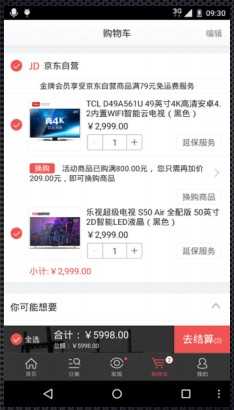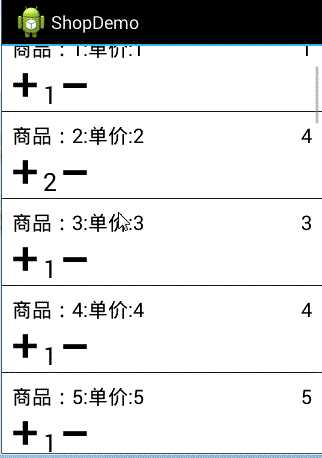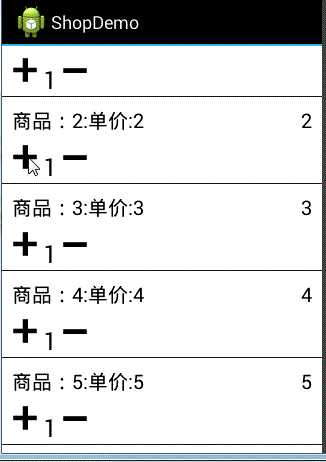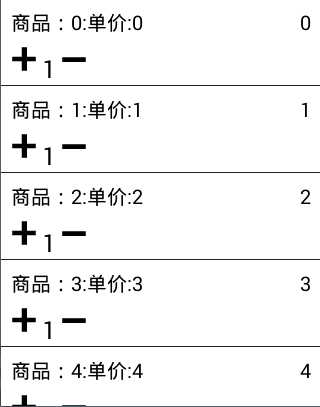标签:
首先,众所周知,ListView是Android最常用的控件,可以说是最简单的控件,也可以说是最复杂的控件。
作为一个Android初级开发者,可能会简单的ListView展示图文信息。
作为一个有一定项目开发经验的Android开发者来说,可能会遇到ListView的列表项中存在各种按钮的需求。
需求最多的就是购物车功能。想必大家都用过某宝某东客户端APP吧 ,就是那个购物车的功能。

-------------------------------------------------------------------------------------------------------------
曾经做过购物车功能,今天项目需求也用到了差不多效果的购物车功能,刚好园友问了这个问题,便帮忙解答了。
之后,想了想还是写一下关于购物车效果的博客吧。
--------------------------------------------------------------------------------------------------------------
那么现在就学习一下购物车功能的实现原理
首先让我们分析下实现购物车功能需要解决的问题:
1、在哪里处理按钮的点击响应事件,是适配器 还是 Activity或者Fragment
2、如何知道你点击的按钮是哪一个列表项中的
3、点击某个按钮的时候,如果列表项所需的数据改变了,如何更新UI
4、列表项中存在会获取焦点的各种按钮,会导致列表项无法点击,只能点击按钮,这种情况怎么解决
首先,我们必须要了解:
1、自定义适配器,不会的看下博客:安卓开发_浅谈ListView(自定义适配器)
2、接口回调,不会接口回调的可以看下博客:Android接口回调机制
一个ListView数据展示的实现,必须要有的 自定义适配器,数据源,ListView,列表项布局
做一个Demo,看下效果
(1)、效果一,点击商品添加删除数量,后面的商品总价随之变化

(2)、效果二,一个列表项发生变化,滑出界面,在滑回来,该列表项的数据依然存在,列表项的复用不存在问题

一、创建布局文件
1、主布局

1 <?xml version="1.0" encoding="utf-8"?> 2 <LinearLayout xmlns:android="http://schemas.android.com/apk/res/android" 3 android:orientation="vertical" 4 android:layout_width="fill_parent" 5 android:layout_height="fill_parent" 6 > 7 <ListView 8 android:layout_width="fill_parent" 9 android:layout_height="wrap_content" 10 android:id="@+id/listView" 11 /> 12 </LinearLayout>
2、列表项布局

1 <?xml version="1.0" encoding="utf-8"?> 2 <RelativeLayout xmlns:android="http://schemas.android.com/apk/res/android" 3 android:layout_width="match_parent" 4 android:layout_height="match_parent" 5 android:background="#fff" 6 android:descendantFocusability="blocksDescendants" 7 > 8 <TextView 9 android:id="@+id/item_product_name" 10 android:layout_width="wrap_content" 11 android:layout_height="wrap_content" 12 android:textSize="20sp" 13 android:layout_margin="10dp" 14 android:text="商品名称" 15 android:textColor="#000" 16 /> 17 <ImageButton 18 android:id="@+id/item_btn_add" 19 android:layout_width="wrap_content" 20 android:layout_height="wrap_content" 21 android:background="#0000" 22 android:src="@drawable/add" 23 android:layout_below="@+id/item_product_name" 24 android:layout_marginLeft="10dp" 25 /> 26 <TextView 27 android:id="@+id/item_product_num" 28 android:text="1" 29 android:layout_width="wrap_content" 30 android:layout_height="wrap_content" 31 android:textSize="25sp" 32 android:textColor="#000" 33 android:layout_margin="5dp" 34 android:layout_toRightOf="@id/item_btn_add" 35 android:layout_below="@id/item_product_name" 36 /> 37 <ImageButton 38 android:id="@+id/item_btn_sub" 39 android:layout_width="wrap_content" 40 android:layout_height="wrap_content" 41 android:background="#0000" 42 android:src="@drawable/sub" 43 android:layout_below="@id/item_product_name" 44 android:layout_toRightOf="@id/item_product_num" 45 /> 46 <TextView 47 android:id="@+id/item_product_price" 48 android:layout_width="wrap_content" 49 android:layout_height="wrap_content" 50 android:textSize="20sp" 51 android:layout_margin="10dp" 52 android:text="0" 53 android:textColor="#000" 54 android:layout_alignParentRight="true" 55 /> 56 57 </RelativeLayout>
这里解决问题:列表项中存在会获取焦点的各种按钮,会导致列表项无法点击,只能点击按钮,这种情况怎么解决
解决方法,在item列表项布局的最外层父容器中 设置一个属性:
android:descendantFocusability="blocksDescendants"

二、创建实体类
看上图,只需要三个属性,名称,总价格,数量

1 package com.xqx.ShopDemo; 2 3 /** 4 * 购物车实体类 5 * 测试 6 */ 7 public class Product { 8 //商品名称 9 private String name; 10 // 商品数量 11 private int num; 12 // 该商品总价 13 private int price; 14 15 @Override 16 public String toString() { 17 return "Product{" + 18 "name=‘" + name + ‘\‘‘ + 19 ", num=" + num + 20 ", price=" + price + 21 ‘}‘; 22 } 23 24 public void setName(String name) { 25 this.name = name; 26 } 27 28 public void setNum(int num) { 29 this.num = num; 30 } 31 32 public void setPrice(int price) { 33 this.price = price; 34 } 35 36 public String getName() { 37 return name; 38 } 39 40 public int getNum() { 41 return num; 42 } 43 44 public int getPrice() { 45 return price; 46 } 47 }
三、创建适配器(关键!!)
1、创建适配器成员变量
//集合 ,存放ListView的商品实体类数据 private List<Product> products; //上下文 private Context context; //第一步,设置接口 private View.OnClickListener onAddNum; //加商品数量接口 private View.OnClickListener onSubNum; //减商品数量接口
接口看你具体需求,我这里是ImageButton ,所以是 View.OnClickListener
具体看情况,举三个列子,当然还有很多接口,比如单选按钮的

2、创建构造方法:
public ShopAdapter(List<Product> products, Context context) { this.products = products; this.context = context; }
3、创建接口方法
public void setOnAddNum(View.OnClickListener onAddNum){ this.onAddNum = onAddNum; } public void setOnSubNum(View.OnClickListener onSubNum){ this.onSubNum = onSubNum; }
4、重写自定义适配器的除了getView()的三个方法
@Override public int getCount() { int ret = 0; if (products != null) { ret = products.size(); } return ret; } @Override public Object getItem(int i) { return products.get(i); } @Override public long getItemId(int i) { return i; }
5、接下来就是重点了
定义内部类
private static class ViewHolder{ //商品名称,数量,总价 private TextView item_product_name; private TextView item_product_num; private TextView item_product_price; //增减商品数量按钮 private ImageButton item_btn_add; private ImageButton item_btn_sub; }
重写最重要的getView()方法,主要看红色颜色部分
@Override public View getView(int i, View view, ViewGroup viewGroup) { View v = null; if (view != null) { v = view; }else{ v = LayoutInflater.from(context).inflate(R.layout.item_cart,viewGroup,false); } ViewHolder holder = (ViewHolder) v.getTag(); if (holder == null) { holder = new ViewHolder(); holder.item_product_name = (TextView) v.findViewById(R.id.item_product_name); holder.item_product_num = (TextView) v.findViewById(R.id.item_product_num); holder.item_product_price = (TextView) v.findViewById(R.id.item_product_price); //设置接口回调,注意参数不是上下文,它需要ListView所在的Activity或者Fragment处理接口回调方法 holder.item_btn_add = (ImageButton) v.findViewById(R.id.item_btn_add); holder.item_btn_add.setOnClickListener(onAddNum); holder.item_btn_sub = (ImageButton) v.findViewById(R.id.item_btn_sub); holder.item_btn_sub.setOnClickListener(onSubNum); } holder.item_product_name.setText(products.get(i).getName()); holder.item_product_num.setText(products.get(i).getNum()+""); holder.item_product_price.setText(products.get(i).getPrice() + ""); //设置Tag,用于判断用户当前点击的哪一个列表项的按钮,解决问题:如何知道你点击的按钮是哪一个列表项中的 holder.item_btn_add.setTag(i); holder.item_btn_sub.setTag(i); v.setTag(holder); return v; }
至此,自定义适配器部分完成了。
适配器完整代码:

1 import android.content.Context; 2 import android.view.LayoutInflater; 3 import android.view.View; 4 import android.view.ViewGroup; 5 import android.widget.BaseAdapter; 6 import android.widget.ImageButton; 7 import android.widget.ImageView; 8 import android.widget.TextView; 9 10 import java.util.List; 11 12 /** 13 * 购物车功能 14 * 适配器 15 */ 16 public class ShopAdapter extends BaseAdapter{ 17 18 //集合 ,存放ListView的商品实体类数据 19 private List<Product> products; 20 //上下文 21 private Context context; 22 23 //第一步,设置接口 24 private View.OnClickListener onAddNum; 25 private View.OnClickListener onSubNum; 26 27 //第二步,设置接口方法 28 public void setOnAddNum(View.OnClickListener onAddNum){ 29 this.onAddNum = onAddNum; 30 } 31 32 public void setOnSubNum(View.OnClickListener onSubNum){ 33 this.onSubNum = onSubNum; 34 } 35 public ShopAdapter(List<Product> products, Context context) { 36 this.products = products; 37 this.context = context; 38 } 39 40 @Override 41 public int getCount() { 42 int ret = 0; 43 if (products != null) { 44 ret = products.size(); 45 } 46 return ret; 47 } 48 49 @Override 50 public Object getItem(int i) { 51 return products.get(i); 52 } 53 54 @Override 55 public long getItemId(int i) { 56 return i; 57 } 58 59 @Override 60 public View getView(int i, View view, ViewGroup viewGroup) { 61 View v = null; 62 if (view != null) { 63 v = view; 64 }else{ 65 v = LayoutInflater.from(context).inflate(R.layout.item_cart,viewGroup,false); 66 } 67 68 ViewHolder holder = (ViewHolder) v.getTag(); 69 if (holder == null) { 70 holder = new ViewHolder(); 71 holder.item_product_name = (TextView) v.findViewById(R.id.item_product_name); 72 holder.item_product_num = (TextView) v.findViewById(R.id.item_product_num); 73 holder.item_product_price = (TextView) v.findViewById(R.id.item_product_price); 74 75 //第三步,设置接口回调,注意参数不是上下文,它需要ListView所在的Activity或者Fragment处理接口回调方法 76 holder.item_btn_add = (ImageButton) v.findViewById(R.id.item_btn_add); 77 holder.item_btn_add.setOnClickListener(onAddNum); 78 79 holder.item_btn_sub = (ImageButton) v.findViewById(R.id.item_btn_sub); 80 holder.item_btn_sub.setOnClickListener(onSubNum); 81 82 } 83 84 holder.item_product_name.setText(products.get(i).getName()); 85 holder.item_product_num.setText(products.get(i).getNum()+""); 86 holder.item_product_price.setText(products.get(i).getPrice() + ""); 87 88 //第四步,设置Tag,用于判断用户当前点击的哪一个列表项的按钮 89 holder.item_btn_add.setTag(i); 90 holder.item_btn_sub.setTag(i); 91 92 v.setTag(holder); 93 return v; 94 } 95 private static class ViewHolder{ 96 //商品名称,数量,总价 97 private TextView item_product_name; 98 private TextView item_product_num; 99 private TextView item_product_price; 100 //增减商品数量按钮 101 private ImageButton item_btn_add; 102 private ImageButton item_btn_sub; 103 104 } 105 }
四、主Activity
public class MainActivity extends Activity implements View.OnClickListener, AdapterView.OnItemClickListener { private List<Product> datas; //数据源 private ShopAdapter adapter; //自定义适配器 private ListView listView; //ListView控件 @Override public void onCreate(Bundle savedInstanceState) { super.onCreate(savedInstanceState); setContentView(R.layout.main); listView = (ListView) findViewById(R.id.listView); // 模拟数据 datas = new ArrayList<Product>(); Product product = null; for (int i = 0; i < 30; i++) { product = new Product(); product.setName("商品:"+i+":单价:"+i); product.setNum(1); product.setPrice(i); datas.add(product); } adapter = new ShopAdapter(datas,this); listView.setAdapter(adapter); //以上就是我们常用的自定义适配器ListView展示数据的方法了
//解决问题:在哪里处理按钮的点击响应事件,是适配器 还是 Activity或者Fragment,这里是在Activity本身处理接口 //执行添加商品数量,减少商品数量的按钮点击事件接口回调 adapter.setOnAddNum(this); adapter.setOnSubNum(this); listView.setOnItemClickListener(this);
}
//
3、点击某个按钮的时候,如果列表项所需的数据改变了,如何更新UI
@Override public void onClick(View view) { Object tag = view.getTag(); switch (view.getId()){ case R.id.item_btn_add: //点击添加数量按钮,执行相应的处理 // 获取 Adapter 中设置的 Tag if (tag != null && tag instanceof Integer) { //解决问题:如何知道你点击的按钮是哪一个列表项中的,通过Tag的position int position = (Integer) tag; //更改集合的数据 int num = datas.get(position).getNum(); num++; datas.get(position).setNum(num); //修改集合中商品数量 datas.get(position).setPrice(position*num); //修改集合中该商品总价 数量*单价
//解决问题:点击某个按钮的时候,如果列表项所需的数据改变了,如何更新UI adapter.notifyDataSetChanged(); } break; case R.id.item_btn_sub: //点击减少数量按钮 ,执行相应的处理 // 获取 Adapter 中设置的 Tag if (tag != null && tag instanceof Integer) { int position = (Integer) tag; //更改集合的数据 int num = datas.get(position).getNum(); if (num>0) { num--; datas.get(position).setNum(num); //修改集合中商品数量 datas.get(position).setPrice(position * num); //修改集合中该商品总价 数量*单价 adapter.notifyDataSetChanged(); } } break; } } @Override public void onItemClick(AdapterView<?> adapterView, View view, int i, long l) { Toast.makeText(MainActivity.this,"点击了第"+i+"个列表项",Toast.LENGTH_SHORT).show(); } }
----------------------------------------------------------------------------------------------------
总结下:
1、有人说列表项中最好不要用ImageButton,而尽可能的用ImageView替代,目前没有发现使用ImageButton会发生什么错误
2、有人说列表项中 解决焦点问题需要两步:
(1)、最外层父容器需要加属性:
android:descendantFocusability="blocksDescendants"
(2)、能获取焦点的控件,Button,ImageButton等等 需要 有属性:android:focusable="false"
但是我实际测试 发现子空间不需要设置focusable属性也不会产生问题,当然加上也没有问题
3、没有做过列表项中存在EditText控件的情况,可能会有焦点冲突。毕竟购物车中加一个编辑框也很少见
最后,一个实际的购物车,当然还需要显示当前的总金额,包含“去结算”按钮的功能的那一个框,这不属于ListView
如图:

那么怎么处理当你操作列表项中的按钮,不仅列表项中的数据发生变哈,而且不属于列表项的下面部分的“合计”数据也发生变化呢,
这就要学习Adapter中观察者模式的应用 了。
---------------------------------------------------------------------------------------------
以上内容,如有错误,欢迎指出!
标签:
原文地址:http://www.cnblogs.com/xqxacm/p/4963145.html